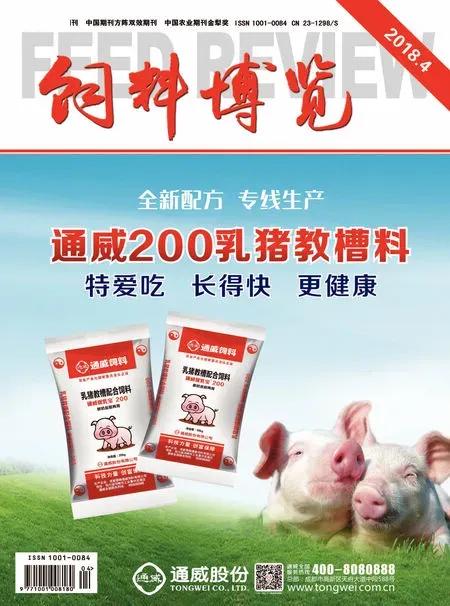乳酸菌改善肠道防御功能的研究进展
2018-03-19时云朵
时云朵,孙 豪
(1.四川省水产学校,成都 611730;2.雅安市农业局畜牧发展中心,四川 雅安 625000)
乳酸菌是人体肠道和泌尿生殖道常见原住菌群,该属的菌株已被广泛用作益生菌。活性乳酸菌对动物机体有许多的生理功能:不仅可促进营养物质消化吸收,降低胆固醇,抑制病原菌,维持肠道菌群平衡,还可维持神经系统的正常功能,调节机体免疫,改善胃肠道功能[1-2]。乳酸菌在调节宿主肠道防御功能方面展现极为重要的作用。本文在国内外研究基础上,综述了乳酸菌对肠道防御调节作用及其可能机制。
1 产生抗菌物质
1.1 乳酸和过氧化氢
乳酸菌产生乳酸和过氧化氢被认为在预防病原微生物定植和繁殖中发挥重要作用。研究表明,乳酸菌通过分泌的乳酸改变细胞膜的通透性,降低肠道pH和Eh,从而灭活沙眼衣原体等病原菌[3]。戊糖乳杆菌LPS16产生的乳酸可抑制多重耐药幽门螺杆菌的活性[4]。由于乳酸积累,鼠李糖乳杆菌GG对鼠伤寒沙门氏菌具有强抗菌活性[5]。乳酸菌产生的过氧化氢也是一种重要的抗菌化合物,能够激活肠道内的过氧化物酶-硫氰酸盐反应系统,并与过氧化物酶结合,将硫氰酸盐氧化成氧化性中间产物,抑制病原菌的生长[6-7]。
1.2 细菌素
细菌素是一类选择性地作用于细菌靶细胞的杀菌或抑菌物质,大多属于多肽类分子。部分乳酸菌产生的细菌素属于低分子量细菌素,可通过诱导致病菌细胞膜的通透化,使得致病菌的胞内物质外流,从而达到抑菌或杀菌作用[8]。目前,乳酸菌细菌素有gassericin A、reutericin 6、Acidocin A和Acidocin B等[9-11]。此外乳酸杆菌也会产生一定的抗生素。罗伊氏乳杆菌ATCC55730菌株产生罗伊氏抗生素(3-羟基丙醛),其是一种广谱抗生素,不仅对革兰氏阳性和革兰氏阴性细菌具有抗生素活性,而且对酵母菌、真菌、原生动物和病毒均具有抗生素活性[12-13]。Corr等研究表明,唾液乳杆菌UCC118产生的Abp118细菌素在体内可显著保护小鼠免受食源性侵入病原体单增李斯特菌的感染,而发生稳定突变的唾液乳杆菌UCC118不能产生Abp118细菌素,导致小鼠被两株单增李斯特菌EGDE和LO28感染[14]。
2 竞争黏附作用
2.1 竞争资源
乳酸杆菌可通过对宿主有限资源的竞争来抑制病原菌。除竞争营养物之外,乳酸菌与病原菌还要竞争微量元素等。铁元素几乎是所有的细菌必不可少的元素,嗜酸乳杆菌和德氏乳杆菌细菌表面可以结合氢氧化铁,导致铁元素不被病原微生物利用[15-16]。
2.2 抗黏附作用
细胞培养试验表明,乳酸菌能够黏附上皮细胞,形成菌膜,从而阻断病原体的附着,这种机制在乳酸菌对宿主的作用中扮演重要角色。这种抗粘附作用可能是益生菌和致病菌竞争同一受体或诱导增加产生黏蛋白的结果。Mack等研究表明,HT20-MTX细胞与植物乳杆菌299v或鼠李糖乳杆菌GG共培养时,能够诱导产生MUC3黏蛋白,MUC3黏蛋白随后抑制了肠致病性大肠杆菌E2348/69的黏附[17]。乳酸菌最突出的黏附特性是其表面蛋白,如罗伊氏乳杆菌1063的黏液结合蛋白MUB[18]。其具有共同特性,比如信号肽的存在,细胞壁C-末端锚定模体(LPXTG:L-亮氨酸、P-脯氨酸、X-任意氨基酸、T-苏氨酸、G-甘氨酸)和几个含有假定黏附功能的重复域[19]。除了表面蛋白黏附排斥,乳酸菌与致病菌也竞争相同受体,其他抗黏附模式的表达可能是分泌蛋白降解碳水化合物受体,建立生物膜,产生受体类似物和诱导生物表面活性剂[20]。
2.3 抗侵袭作用
Hess等采用庆大霉素保护法量化侵袭性,在细胞培养试验中,细胞内外之间的细菌差异通过庆大霉素杀死细胞外的细菌来实现。细胞内细菌的数量通过上皮细胞裂解液菌落计数测定[21]。乳酸菌所产生的抗菌物质可导致细胞内细菌数量减少,尽管这些物质不会直接抑制侵袭而只是杀死病原体,但也有部分乳酸菌能够特异性干扰细菌入侵宿主细胞。研究表明,部分益生乳酸菌的分泌物能干扰大肠杆菌或李斯特杆菌侵宿主上皮细胞[22]。乳酸菌抑制病原体侵入肠上皮细胞这种体外属性在体内是否存在,必须在将作用相关基因与等位基因突变及亲缘菌株鉴定后,在动物试验中验证。
3 抗毒素作用
绝大多数细菌毒力因子是毒素,部分乳酸菌可抑制病原微生物毒素基因表达来中和、降解毒素,从而发挥抗毒素能力。伴放线放线杆菌与局部侵袭性牙周炎的发生密切相关,唾液乳杆菌OMZ520和加氏乳酸杆菌OMZ525无细胞上清可下调该致病菌白细胞毒素(LtxA)和细胞致死肿胀毒素(CdtB)[23]。与此类似,Mundi等研究表明,嗜酸乳杆菌无细胞上清培养液能抑制空肠弯曲杆菌81-176毒力基因ciaB和flaA的表达,而活化甲基周期被打乱的luxS突变菌株只有ciaB毒力基因被抑制,同型半胱氨酸的补充恢复了被破坏的周期,继而恢复乳酸菌对两种毒力基因的抑制作用[24]。乳酸杆菌分泌的高浓度有机酸抑制肠出血性大肠杆菌O157∶H7志贺毒素2A的表达,而菌体能与EHEC O157∶H7志贺毒素(Stx)B亚基的结合,降低后者对Vero细胞的毒性作用[25-26]。
部分乳酸菌预防真菌毒素对宿主的保护是主要基于毒素和乳酸菌之间的物理化学作用。热和酸灭活的鼠李糖乳杆菌GG对玉米赤霉烯酮展现出较高的结合性能,但这种结合是可逆的,在水洗时能重新释放[27]。Turner等发现,鼠李糖乳杆菌GG能够结合脱氧雪腐镰刀菌烯醇,限制这种毒素的生物利用度,从而恢复肠分化中Caco-2细胞的碱性磷酸酶活性[28]。此外,乳酸菌还能结合黄曲霉毒素毒素B1(AFB1)等真菌毒素。李志刚等研究表明,乳酸菌结合AFB1的强度为4%~5%,而被结合的AFB1仍具有较强的致突变性,而体内试验表明,植物乳杆菌BS22、鼠李糖乳杆菌GG能够调节肠道的吸收,减少AFB1在体内的蓄积量,促进随粪便排泄量,减缓肝损伤[29-31]。体外研究表明,鼠李糖乳杆菌GG降低细胞对AFB1的吸收,并防止了细胞膜和DNA的损伤[32]。同时,部分乳酸菌能产生抗霉菌毒素类似物,抑制AFB1的合成。Gourama等研究表明,乳酸菌培养液的无细胞上清液可以显著抑制AFB1的合成,但具体是上清液中什么物质还不太清楚[33]。此外,部分乳酸菌还能直接降解AFB1。Megalla等用乳酸菌发酵牛乳,发现乳中AFB1转化为无毒的AFB2和低毒的 AFR0[34]。
4 肠道黏膜免疫调节作用
乳酸菌菌体、代谢产物及细胞壁均有免疫刺激特性,能刺激肠道黏膜免疫系统,激活先天性免疫应答[35]。乳酸菌到达消化道后,被M细胞与上皮细胞内化进入小肠内腔。乳酸菌菌体或片段被肠上皮细胞内化后,先与消化道固有膜中的抗原呈递细胞、巨噬细胞和(或)树突状细胞相互作用,诱导上皮细胞释放IL-6。巨噬细胞和树突状细胞吞噬乳酸菌或片段,从而诱导TNF-α、IFN-γ、IL-10和IL-6等细胞因子的产生。TNF-α是启动黏膜相关的免疫细胞和肠上皮细胞相互作用所必须的因子,而IFN-γ则是一些免疫细胞成熟所必须的[36]。诱导释放的IL-6能够促进分泌IgA+的B细胞的增殖,导致分泌IgA细胞数量的增加及向肠固有层浆细胞靠近通路的增多[37]。IL-6、IL-4和TGF-β结合能够诱导胸腺依赖性B细胞表面抗原从IgM转变为IgA,增加肠道固有膜分泌IgA的B细胞的数量[38]。此外,免疫细胞产生的IL-10、IL-6、IL-4和TGF-β能够促进胸腺依赖细胞,通过乳酸菌刺激能够诱导IgA循环,增加肠道远端黏膜处IgA分泌细胞数量。IgA分泌细胞移到肠系膜淋巴结后穿过胸导管到达循环系统,到达支气管和乳腺,促使机体分泌大量的IgA以抵御病原菌的侵袭[38]。Liu等研究表明,大熊猫源植物乳杆菌BSGP201683能上调大肠杆菌攻毒组小鼠空肠中IL-1β、IL-6、IL-8、TLR-4和MyD88的表达,最终导致大肠杆菌攻毒组小鼠结肠中的肠杆菌科细菌数量下降[39]。
5 小 结
乳酸菌通过分泌抗菌物质、竞争排斥、调节肠道免疫、改善肠道菌群等方式发挥益生作用。目前研究主要侧重于乳酸菌的免疫调节和竞争黏附作用效果,其作用的前提是乳酸菌表面成分与肠道上皮细胞受体的互作,但乳酸菌表面成分与受体之间具体识别方式仍然不明了,有关表面成分在肠道识别后的信号启动与传导机制仍待进一步深入研究,并且随着基因工程以及生物技术的发展,相信在乳酸菌的功能作用机制研究上可以取得更大的进步。
[参考文献]
[1] 骆鹏飞,俞兰秀,钟霞,等.乳酸菌对精神性疾病作用的研究进展[J].食品工业科技,2017(16):347-351.
[2] 代永刚,田志刚,南喜平.乳酸菌及其生理功能研究的进展[J].农产品加工·学刊,2009(7):24-26.
[3] Gong Z,Luna Y,Yu P,et al.LactobacilliinactivateChlamydia trachomatisthrough lactic acid but not H2O2[J].Plos One,2014,9(9):107 758.
[4] Zheng P X,Fang H Y,Yang H B,et al.Lactobacilluspentosus strain LPS16 produces lactic acid,inhibiting multidrug-resistantHelicobacter pylori[J].Journal of Microbiology Immunology&In⁃fection,2016,49(2):168-174.
[5] De Keersmaecker S C,Verhoeven T L,Desair J,et al.Strong anti⁃microbial activity ofLactobacillus rhamnosusGG againstSalmo⁃nella typhimuriumis due to accumulation of lactic acid[J].Fems Microbiology Letters,2006,259(1):89-96.
[6] Voltan S,Martines D,Elli M,et al.Lactobacillus crispatus M247-derived H2O2acts as a signal transducing molecule activating per⁃oxisome proliferator activated receptor-gamma in the intestinal mucosa[J].Gastroenterology,2008,135(4):1 216-1 227.
[7] Otero M C,Nader-Macías M E.Inhibition ofStaphylococcus aure⁃usby H2O2-producingLactobacillus gasseriisolated from the vagi⁃nal tract of cattle[J].Animal Reproduction Science,2006,96(1/2):35-46.
[8] 贡汉生,孟祥晨.乳酸菌细菌素分类与作用机制[J].食品与发酵工业,2008,34(1):105-109.
[9] Nakamura K,Arakawa K,Kawai Y,et al.Food preservative poten⁃tial of gassericin A-containing concentrate prepared from a cheese whey culture supernatant fromLactobacillus gasseriLA39[J].Animal Science Journal,2013,84(2):144-149.
[10] Pandey N,Malik R K,Kaushik J K,et al.Gassericin A:a circular bacteriocin produced by lactic acid bacteriaLactobacillus gasseri[J].World Journal of Microbiology&Biotechnology,2013,29(11):1 977-1 987.
[11] Majhenic A C,Venema K,Allison G E,et al.DNA analysis of the genes encoding acidocin LF221 A and acidocin LF221 B,two bac⁃teriocins produced byLactobacillus gasseriLF221[J].Applied Mi⁃crobiology&Biotechnology,2004,63(6):705-714.
[12] Talarico T L,Casas I A,Chung T C,et al.Production and isolation of reuterin,a growth inhibitor produced byLactobacillus reuteri[J].Antimicrobial Agents&Chemotherapy,1988,32(12):1 854-1 858.
[13] Cleusix V,Lacroix C,Vollenweider S,et al.Glycerol induces reuterin production and decreasesEscherichia colipopulation in an in vitro model of colonic fermentation with immobilized human feces[J].Fems Microbiology Ecology,2008,63(1):56-64.
[14] Corr S C,Li Y,Riedel C U,et al.Bacteriocin production as a mechanism for the antiinfective activity ofLactobacillus salivariusUCC118[J].Proceedings of the National Academy of Sciences of the United States of America,2007,104(18):7 617-7 621.
[15] Weinberg E D.TheLactobacillusanomaly:total iron abstinence[J].Perspectives in Biology&Medicine,1997,40(4):578-583.
[16] Elli M,Zink R,Rytz A,et al.Iron requirement ofLactobacillusspp.in completely chemically defined growth media[J].Journal of Applied Microbiology,2000,88(4):695-703.
[17] Mack D R,Ahrne S,Hyde L,et al.Extracellular MUC3 mucin se⁃cretion follows adherence ofLactobacillus strainsto intestinal epi⁃thelial cellsin vitro[J].Gut,2003,52(6):827-833.
[18] Roos S,Jonsson H.A high-molecular-mass cell-surface protein fromLactobacillus reuteri1063 adheres to mucus components[J].Microbiology,2002,148(2):433-442.
[19] Sánchez B,Bressollier P,Urdaci M C.Exported proteins in probi⁃otic bacteria:adhesion to intestinal surfaces,host immunomodula⁃tion and molecular cross-talking with the host[J].Fems Immunolo⁃gy&Medical Microbiology,2008,54(1):1-17.
[20] Chen X Y,Woodward A,Zijlstra R T,et al.Exopolysaccharides synthesized byLactobacillus reuteriProtect against Enterotoxigen⁃icEscherichia coliin Piglets[J].Appl Environ Microbiol,2014,80(18):5 752-5 760.
[21] Hess P,Altenhöfer A,Khan A S,et al.A Salmonella fim homo⁃logue in Citrobacter freundii mediates invasionin vitroand cross⁃ing of the blood-brain barrier in the rat pup model[J].Infection&Immunity,2004,72(9):5 298-5 307.
[22] Botes M,Loos B,Reenen C A V,et al.Adhesion of the probiotic strainsEnterococcus mundtiiST4SA andLactobacillus plantarum423 to Caco-2 cells under conditions simulating the intestinal tract,and in the presence of antibiotics and anti-inflammatory medicaments[J].Archives of Microbiology,2008,190(5):573-584.
[23] Nissen L,Sgorbati B,Biavati B,et al.Lactobacillus salivariusandL.gasseridown-regulate aggregatibacter actinomycetemcomitans exotoxins expression[J].Annals of Microbiology,2014,64(2):611-617.
[24] Mundi A,Delcenserie V,Amirijami M,et al.Cell-free prepara⁃tions ofLactobacillus acidophilusstrain La-5 andBifidobacterium longumstrain NCC2705 affect virulence gene expression in Cam⁃pylobacter jejuni[J].Journal of Food Protection,2013,76(10):1 740-1 746.
[25] Carey C M,Kostrzynska M,Ojha S,et al.The effect of probiotics and organic acids on Shiga-toxin 2 gene expression in enterohem⁃orrhagicEscherichia coliO157∶H7[J].Journal of Microbiological Methods,2008,73(2):125-132.
[26] Kakisu E,Abraham A G,Farinati C T,et al.Lactobacillus planta⁃rumisolated from kefir protects vero cells from cytotoxicity by type-II shiga toxin fromEscherichia coliO157∶H7[J].Journal of Dairy Research,2013,80(1):64-71.
[27] El-Nezami H,Polychronaki N,Lee Y K,et al.Chemical moieties and interactions involved in the binding of zearalenone to the sur⁃face ofLactobacillus rhamnosusstrains GG[J].J Agric Food Chem,2004,52(14):4 577-4 581.
[28] Turner P C,Wu Q K,Piekkola S,et al.Lactobacillus rhamnosus,strain GG restores alkaline phosphatase activity in differentiating Caco-2 cells dosed with the potent mycotoxin deoxynivalenol[J].Food&Chemical Toxicology,2008,46(6):2 118-2 123.
[29] 李志刚,杨宝兰,姚景会,等.乳酸菌对黄曲霉毒素B1吸附作用的研究[J].中国食品卫生杂志,2003,15(3):212-215.
[30] 张艳,曾东,倪学勤,等.植物乳杆菌BS22对黄曲霉毒素B1的吸附效果及对肉鸡消化道菌群的影响[J].湖南农业大学学报:自科版,2015,41(3):286-293.
[31] Gratz S,Täubel M,Juvonen R O,et al.Lactobacillus rhamnosusstrain GG modulates intestinal absorption,fecal excretion,and tox⁃icity of aflatoxin B1in rats[J].Applied&Environmental Microbiol⁃ogy,2006,72(11):7 398-7 400.
[32] Gratz S,Wu Q K,El-Nezami H,et al.Lactobacillus rhamnosusstrain GG reduces aflatoxin B1transport,metabolism,and toxicity in Caco-2 Cells[J].Applied&Environmental Microbiology,2007,73(12):3 958-3 964.
[33] Gourama H,Bullerman L B.Antimycotic and antiaflatoxigenic effect of lactic acid bacteria:a review[J].Journal of Food Protec⁃tion,1995,58(11):1 275-1 280.
[34] Megalla S E,Mohran M A.Fate of aflatoxin B-1 in fermented dairy products[J].Mycopathologia,1984,88(1):27-29.
[35] Baarlen P V,Wells J M,Kleerebezem M.Regulation of intestinal homeostasis and immunity with probiotic lactobacilli[J].Trends in Immunology,2013,34(5):208-215.
[36] 程福亮,王丽荣,王春凤,等.乳酸菌对肠道黏膜免疫影响的研究进展[J].饲料博览,2013(12):12-15.
[37] Citar M,Hacin B,Tompa G,et al.Human intestinal mucosa-asso⁃ciatedLactobacillusandBifidobacteriumstrains with probiotic properties modulate IL-10,IL-6 and IL-12 gene expression in THP-1 cells[J].Beneficial Microbes,2015,6(3):325-336.
[38] Galdeano C M,Leblanc A D M D,Vinderola G,et al.Proposed,model:mechanisms of immunomodulation induced by probiotic Bacteria[J].Clinical&Vaccine Immunology Cvi,2007,14(5):485-492.
[39] Liu Q,Ni X,Wang Q,et al.Lactobacillus plantarumBSGP201683 isolated from giant panda feces attenuated inflammation and improved gut microflora in mice challenged with enterotoxigenicEscherichia coli[J].Frontiers in Microbiology,2017,8:1 885.
